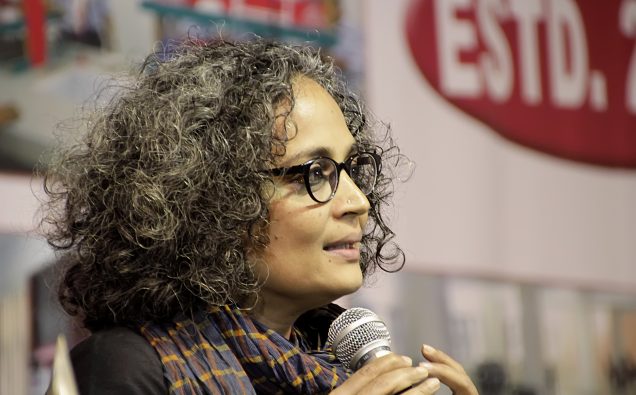
Photo: Vikramjit Kakati/ Wikimedia Commons
The horrible plight of mothers of the disappeared youth in Indian-ruled Kashmir, the uncertainty of life and scant regard for human rights in the one of the world’s most heavily militarized occupations, the precious years of youth lost to the conflict.
Arundhati Roy has much to tell about the unspeakable Indian crimes against humanity, which she feels and describes intensely from the perspective of a human rights advocate.
The highly respected author of The God of Small Things has returned to fiction after two decades. This time encapsulating the festering wounds of individuals and communities in a world where the governments and states – as New Delhi does in the case of UN-recognized disputed territory of Kashmir – try to suppress and deny inalienable rights of a people by painting demands for freedom as extremism.
The Ministry of Utmost Happiness is a book that documents the pain of character Anjum, a woman who has moved to live in a graveyard.
Between her two fiction works, Roy has been championing the cause of human rights and has faced allegations of sedition for telling the world that Kashmir is not an integral part of India.
All through these years, India’s harsh suppression of Kashmirs – under draconian laws which provide immunity to Indian army and security forces – has gotten worse. That Kashmiris are being subjected to collective punishment would be an understatement – and things have deteriorated in India with the rise of BJP ultranationalists who want to close doors on secularism and deny a rightful place to Indian Muslims and other minorities.
During her several appearances for the launch of the book, Roy explained to Americans what her latest book is about – a continuity in depiction of the sufferings of human beings from the pages of The God of Small Things to the Ministry of Utmost Happiness.
“Well, actually, to me, Tilo, Tilottama, is the fictional child of Ammu and Velutha in The God of Small Things, had their story ended differently. She’s the younger sibling of Esthappen and Rahel. So, you know, I know her well, but I’m not her,” Roy told Amy Goodman of Democracy Now.
Here are some of the Roy’s remarks that shed light on her work:
“So—and, of course, Kashmir is—you know, the mothers of the disappeared in Kashmir are also in the book and in that place. And the baby appears actually right next to them, and so there’s this whole thing about how the mothers of the disappeared don’t know what to do with a baby that has appeared, you know? And then, one of—Tilottama is a character who actually just picks up the baby and runs, you know, because the police have come. And Anjum wants her, the baby, and that’s how kind of it gets connected. And Tilo has a long connection with Kashmir.
“And the thing about Kashmir is that, yes, I’ve been going there for many years, and my dearest friends are Kashmiri, actually. And I realized long ago, when I started visiting it, that you cannot tell anything that remotely resembles the truth about Kashmir in reportage, in human rights reports, in the documentation of the dead or the torture or the atrocities, because it’s not just that.
“You know, what do you do when a people have lived under the most—under the densest military occupation in the world for 25 years? What does it do to the air? What does it do to the soldiers? What does it do to the army? What does it do to the collaborators? What does it do to the intelligence people? What does it do to people who don’t know when their children will come home?
“Now you see schoolgirls throwing stones at the army. You know, last year, they blinded people with pellet guns. And, crucially, what does it do to Indians, who are not protected from this war? They are fed these atrocities as—you know, with a soundtrack of applause, and we are supposed to swallow this absolute cruelty and keep it in our stomachs.”
Roy also put the Kashmiris’ struggle in context during her interview with Democracy Now:
“Well, Kashmir was—at the time of independence, in 1947, Kashmir was one—Jammu and Kashmir was one of the independent princely kingdoms, one of the 500-and-something princely kingdoms, who were all required to decide whether they wanted to be with India or Pakistan. And Kashmir, of course, had a majority-Muslim population but a Hindu king. And it’s called the “unfinished business of [partition],” because, you know, initially, the king didn’t decide while partition and bloodshed was happening—also in Jammu, which is part of the state of Jammu and Kashmir. And then, eventually, he fled to India and signed a secession based on the fact that there would be a referendum, which there never was. And so it’s, as I said, called the unfinished business of Pakistan [sic], but—I mean, of partition.
“But so, India and Pakistan have been fighting over it, and it’s become a toxic situation, a flashpoint. The Indian Muslim population is, of course, held hostage to all the debates between India and Pakistan in Kashmir. And we’re talking about two nuclear powers. So, you’re talking about a place with—proliferating with graveyards. In the ’90s, the struggle turned militant. The army was fighting militants. Now the population has turned militant. Recently, the army general said that he wished the people who are throwing stones were actually firing at them, so he could do what he liked with them. Just last month, they tied a Kashmiri civilian to a tank, used him as a human shield, and the officer who did that was rewarded, was honored, and many people in India applauded it. And that’s by no means the worst thing that has happened there.”


















